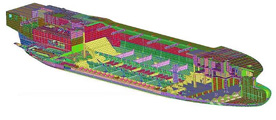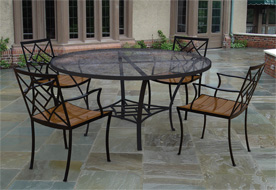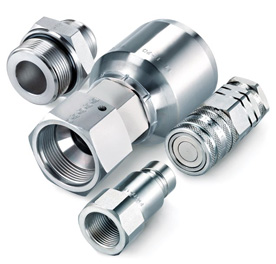Templates in NX CAM are utilized to save programming time and the possibility of errors. When utilizing templates, the programmed tool, speeds, feeds, non-cutting moves, cutting parameters, and cut patterns should be consistent.
Templates can also be utilized to consistently process your machined parts in very similar sequences.
If applied properly the programmer should only need to re-select the geometry intended to program.
Any NX CAM file can be utilized at any time as a template. The following steps show just how easy using existing files as templates is:
When creating an operation select the browse option:
Locate to the file you wish to utilize as your template file. Select the file and select the OK button.
The operations that you have created in your selected file appears as your available operations.
Note: In the example shown, Only 3 operations exist
For best results attach the template to the geometry level in your operation navigator.
Note: Parts can be used as Templates pulling versions forward, but not backwards. (NX7.5 file can be a template in NX9.0, but NX9.0 files cannot be used as a template in NX7.5)
Want to learn more about NX CAM? Attend or request a training course here.
Written by
Brian Brown
Application Engineer
Swoosh Technologies
Thursday, August 28, 2014
Wednesday, August 27, 2014
Nucleic acids provider speeds DNA synthesis machine design with more data re-use
Integrated DNA Technologies designs better with Solid Edge. Serving academic, government and commercial researchers in biotechnology, clinical diagnostics and pharmaceutical development, the company also uses Solid Edge and Teamcenter to enhance communication and access to product data company-wide and build new business opportunities.
Learn how here.
Start your 45 day trial of Solid Edge here.
Learn how here.
Start your 45 day trial of Solid Edge here.
Labels:
case study,
Solid Edge,
Teamcenter
Location:
St. Louis, MO, USA
Wednesday, August 20, 2014
Using Femap, expert CAE service provider optimizes designs for its customers
Femtec accelerates simulation of complex designs and delivers optimized products for its customers with Femap from Siemens PLM Software. Other results include creating a better base for design advice, automation of its own projects and development of tools to build a strong track record of reducing product weight while retaining full functionality.
Learn how here.
Start your 45 day free trial of Solid Edge here.
Learn how here.
Start your 45 day free trial of Solid Edge here.
Design and manufacturing services company makes CAD changes 10 times faster than traditional history-based CAD
Trlby Innovative designs better with Solid Edge. The use of synchronous technology helps a small company impress its large company customers. Other results from synchronous technology use include easily beating customer deadlines, exceeding customer expectations and creating designs not feasible in history-based CAD. Trlby provides diversified product design, development and manufacturing services for a client base that is almost exclusively made up of Fortune 500 companies across multiple industries.
Learn how here.
Start a free trial of Solid Edge here.
Learn how here.
Start a free trial of Solid Edge here.
Labels:
case study,
Solid Edge
Location:
St. Louis, MO, USA
How to Acquire an NX9 License File from Siemens PLM
Installing NX is only half of the two main tasks required before NX can run. The second task is to install the license server, which requires a valid NX license file. The following post provides a detailed explanation of acquiring a license file directly from the Siemens PLM GTAC for new and existing NX customers.
Note: You will need a valid Webkey from Siemens PLM that is delivered after your account has been processed.
Starting with NX4, released in 2005, NX uses an updated version of FlexLM from FlexeraSoftware to manage its licenses. Most customers purchase floating licenses but even with node-locked licenses a license server must be installed.
Siemens PLM will issue a temporary 7-day license for you to use until you settle on what machine you want to install as a license server. In the meantime, you need to gather three pieces of information:
• Host ID – the physical address, or MAC address, of the computer’s Ethernet adapter.
• Composite ID – the unique ID generated from the UGS_composite ID utility.
• Hostname – the assigned name of the computer or server on which the license will be installed.
Note: The hostname in the license file is not the same as the host ID. The hostname and the composite ID become part of the NX license file. If Siemens PLM is not provided with the hostname of the license server, it is the customer’s responsibility to enter it themselves.
Running the NX Setup Program
If you have already received the NX Installation media, run the NX setup program, “Launch.exe” from the software installation folder (i.e. nx-9.0.0-64bit) and click the “Get the composite host ID” option.
Acquiring the NX Setup Program
Download the utility from the Siemens PLM website or contact Swoosh Technologies support for the getcid.exe utility and run it on the server machine. The output of the ugs_composite utility looks like this:
Generally, the CID (composite ID) displayed will be the CID of the Ethernet Adaptor within the computer. If other CID’s are listed, they might include a Wi-Fi adaptor or other irrelevant networking devices within the computer. The CID is needed for Siemens to generate the proper licenses and cannot be edited by the customer.
Next log in to the Siemens PLM GTAC website and enter the needed information. Expand the “License Management Group.”
New Customers
If you are a new customer, click “Register your Composite Host ID (CID).”
Select the “Composite Host ID” button.
Register your CID by entering the characters. After completing this step, Siemens will then process the information and generate a license file for THAT computer at your company. This may take 24-48 hours but the file will be emailed to the Customer Contact Email Address on file for your company.
To verify the Customer Contact on file, select the “Sold-To/Install” link shown above.
Existing Customers
If you are an existing customer with a CID on file with Siemens, select the option for “Current Licenses.”
Enter or select your Sold-To/Install number in the upper left and press Enter. Then select the “Passwords and License Files” link.
Select “Unigraphics NX” as the product and then “9” as the Version. (NX9 license files allow previous versions to run.) Then click “Continue”.
A new license file is created based on stored information for that Webkey account (MAC address, Composite ID, etc.). Download and Save the file (defaults to your temp download folder). Download and save the “ugnx9.dat” file to the appropriate folder.
This process works for getting license files for your current server on the file in your account with Siemens PLM. If you need to change server machines, contact Swoosh Technologies here for help in filing the request.
Checking the License File Content
Upon receiving the license file, you want to inspect the content.
1. Check the Sold-To/Install number to make sure it is for NX and not Solid Edge.
2. Check the Contact Name and E-mail Address to make sure it is the name and address of the contact or CAD administrator of the customer and not a contractor or outside service company.
3. Check the creation date.
4. Check that it is an NX9 license file.
5. Note whether or not the server hostname has been included. If not, make sure that an explanation of changing it to the correct hostname is clearly communicated to the customer. The hostname (computer name) of the server MUST be included in the SERVER line of the license file in order for the license to work properly.
6. Check the cid.
7. Check that either the port “28000” or the word “any” follows the cid. This license service uses port 28000 by default, so that port must be unused on the license server or the port number will need to be edited to an unused number, i.e. 28001.
8. Check for an expiration date – there should not be an expiration date if it is a permanent license file.
Have questions? Contact Swoosh Technologies’ support team today by calling (314) 549-8110.
Garrett Koch
Application Engineer
Swoosh Technologies
Note: You will need a valid Webkey from Siemens PLM that is delivered after your account has been processed.
Starting with NX4, released in 2005, NX uses an updated version of FlexLM from FlexeraSoftware to manage its licenses. Most customers purchase floating licenses but even with node-locked licenses a license server must be installed.
Siemens PLM will issue a temporary 7-day license for you to use until you settle on what machine you want to install as a license server. In the meantime, you need to gather three pieces of information:
• Host ID – the physical address, or MAC address, of the computer’s Ethernet adapter.
• Composite ID – the unique ID generated from the UGS_composite ID utility.
• Hostname – the assigned name of the computer or server on which the license will be installed.
Note: The hostname in the license file is not the same as the host ID. The hostname and the composite ID become part of the NX license file. If Siemens PLM is not provided with the hostname of the license server, it is the customer’s responsibility to enter it themselves.
Running the NX Setup Program
If you have already received the NX Installation media, run the NX setup program, “Launch.exe” from the software installation folder (i.e. nx-9.0.0-64bit) and click the “Get the composite host ID” option.
Acquiring the NX Setup Program
Download the utility from the Siemens PLM website or contact Swoosh Technologies support for the getcid.exe utility and run it on the server machine. The output of the ugs_composite utility looks like this:
Generally, the CID (composite ID) displayed will be the CID of the Ethernet Adaptor within the computer. If other CID’s are listed, they might include a Wi-Fi adaptor or other irrelevant networking devices within the computer. The CID is needed for Siemens to generate the proper licenses and cannot be edited by the customer.
Next log in to the Siemens PLM GTAC website and enter the needed information. Expand the “License Management Group.”
New Customers
If you are a new customer, click “Register your Composite Host ID (CID).”
Select the “Composite Host ID” button.
Register your CID by entering the characters. After completing this step, Siemens will then process the information and generate a license file for THAT computer at your company. This may take 24-48 hours but the file will be emailed to the Customer Contact Email Address on file for your company.
To verify the Customer Contact on file, select the “Sold-To/Install” link shown above.
Existing Customers
If you are an existing customer with a CID on file with Siemens, select the option for “Current Licenses.”
Select “Unigraphics NX” as the product and then “9” as the Version. (NX9 license files allow previous versions to run.) Then click “Continue”.
A new license file is created based on stored information for that Webkey account (MAC address, Composite ID, etc.). Download and Save the file (defaults to your temp download folder). Download and save the “ugnx9.dat” file to the appropriate folder.
This process works for getting license files for your current server on the file in your account with Siemens PLM. If you need to change server machines, contact Swoosh Technologies here for help in filing the request.
Checking the License File Content
Upon receiving the license file, you want to inspect the content.
1. Check the Sold-To/Install number to make sure it is for NX and not Solid Edge.
2. Check the Contact Name and E-mail Address to make sure it is the name and address of the contact or CAD administrator of the customer and not a contractor or outside service company.
3. Check the creation date.
4. Check that it is an NX9 license file.
5. Note whether or not the server hostname has been included. If not, make sure that an explanation of changing it to the correct hostname is clearly communicated to the customer. The hostname (computer name) of the server MUST be included in the SERVER line of the license file in order for the license to work properly.
6. Check the cid.
7. Check that either the port “28000” or the word “any” follows the cid. This license service uses port 28000 by default, so that port must be unused on the license server or the port number will need to be edited to an unused number, i.e. 28001.
8. Check for an expiration date – there should not be an expiration date if it is a permanent license file.
Have questions? Contact Swoosh Technologies’ support team today by calling (314) 549-8110.
Garrett Koch
Application Engineer
Swoosh Technologies
Labels:
Garrett Koch,
NX,
NX 9
Location:
St. Louis, MO, USA
Wednesday, August 13, 2014
Solid Edge ST7 Assembly Simulation
Siemens has created great software that allows seamless transition of geometry that may have once seemed impossible or very difficult to make useful as well as time consuming. Solid Edge with the latest release of ST7 has the ability to take a single body translated parasolid file and quickly modify it to have multiple bodies.
Application Engineer, Dylan Malek, walks you through the short steps to converts these bodies into sheet metal parts, which then allow to make mid surface faces. These faces can then be easily and accurately used in Finite Element Analysis or FEA.
Splitting the surface to do point load analysis in most FEA software can be very tedious. However, in Solid Edge ST7, the model in the video below took three simple steps for the part to be ready for a load to be applied.
Have questions? Comment below or contact Swoosh Technologies today to learn more.
Application Engineer, Dylan Malek, walks you through the short steps to converts these bodies into sheet metal parts, which then allow to make mid surface faces. These faces can then be easily and accurately used in Finite Element Analysis or FEA.
Splitting the surface to do point load analysis in most FEA software can be very tedious. However, in Solid Edge ST7, the model in the video below took three simple steps for the part to be ready for a load to be applied.
Have questions? Comment below or contact Swoosh Technologies today to learn more.
Labels:
Dylan Malek,
FEA,
Solid Edge,
ST7
Location:
Dallas, TX, USA
Wednesday, August 6, 2014
Analysis of new fluid transport components identifies critical issues up front
Mechanical and hydraulic power transmission components maker Intertraco uses Femap from Siemens PLM Software for the structural analysis of components before physical tests. With Femap, Intertraco's CAD models accurately anticipate the impact of each modification on product performance. Now Intertraco can calculate load losses on equipment and answer specific questions from its customers.
Learn how here.
Start your free trial of Femap here.
Learn how here.
Start your free trial of Femap here.
Crane manufacturer gains tight control over millions of product configurations
Street Crane designs better with Solid Edge. With Solid Edge, Street Crane addresses the challenges of complex data management, control and access by Internal and external users. The results include significantly improved customer response/support, greater product innovation and tight control over millions of possible product configurations.
Learn how here.
Try Solid Edge free here.
Learn how here.
Try Solid Edge free here.
Labels:
case study,
Solid Edge
Location:
St. Louis, MO, USA
Subscribe to:
Comments (Atom)

















